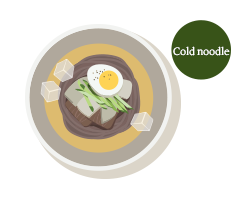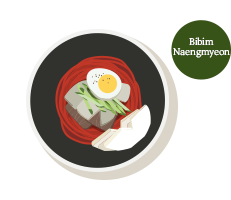Noodle
Community
Noodle
Noodle story Various noodles around the world are interconnected as one
NOODLES
We are developing noodle dishes made out of wheat, buckwheat, potatoes,
and kudzu using traditional methods, which perfectly suit Koreans’ taste.
It is a taste that is remembered by people for a long time just like the long noodles.

- Various noodles around the world
are interconnected as one -
Noodles were spread deep within Asia through the Silk Road.
The Silk Road was an important venue for spreading a variety of culinary cultures beyond mere cultural trade.
Silk Road merchants met with foreign traders from every corner of the world,came in contact with other cultures, and exchanged recipes.
Since then, noodles have quickly spread to China, Korea, and Japan, and also influenced many countries in Southeast Asia.
Noodles that spread in such manner evolved into different forms to suit the tastes of each country.

- Rich and thick soup
with a mouth-filling texture -
Since ancient times, noodles have been inseparable from Koreans.
In fact, Naengmyeon (buckwheat noodles) was a winter food that Koreans used to gather around for and eat in an ondol room (room with underfloor heating) on cold winter days.
Having become a summer delicacy, Naengmyeon is spreading to the entire world as a unique aspect of Korean culinary culture. The reason for this is that buckwheat—the main ingredient of Naengmyeon—has a natural cooling property, making it ideal for cooling the heated body during summer.
Mulnaengmyeon eaten with chilled broth is made by mixing beef or chicken stock with refreshing liquid from kimchi or Dongchimi (radish water kimchi). You can enjoy Naengmyeon with mild-flavored soup, topped with sliced beef, cucumber strips, pear slices, and boiled eggs.

- Spicy and sweet taste that gets
you hooked from the first bite -
As a dish mixing noodles with spicy sauce, Bibimnaengmyeon (spicy buckwheat noodles) goes well with Hamheung-style Naengmyeon.
Because Hamheung-style Naengmyeon contains large amounts of potato and sweet potato starch, it is highly elastic and thin and long.
This makes it ideal for evenly absorbing seasonings and spices, creating a delicious flavor. Enjoy by topping with cucumbers, pear, and eggs along with a spicy sauce made with ground vegetables and fruit.
You can also enjoy a raw-fish cold noodle variation topped with seasoned raw fish such as skate or flatfish. The spicy and sweet taste of Bibimnaengmyeon gets you hooked from the first bite.
How to Enjoy Naengmyeon Deliciously
-
STEP 1
Thaw in cold water

Thaw the frozen noodles in cold water, and then rub them with the palm of your hands to separate each noodle.
-
STEP 2
Cook the noodles







Put 200 g (1 pack) of noodles into 800 cc (about 4 cups) of boiling water and boil for about 2 to 2.5 minutes while stirring gently.
-
STEP 3
Rinse the noodles









If the noodles are cooked, rinse them sufficiently in cold water and then put into a bowl after straining.
-
STEP 4
Mulnaengmyeon

Pour slightly frozen GYODONG cold broth and add garnish, seasoning, or mustard to taste. Stir well and enjoy the noodles.
-
STEP 5
Bibimnaengmyeon

Put a little bit of cold noodle soup and GYODONG spicy sauce, and add garnish according to your preference. Mix well and enjoy the noodles.
Tip: For chewy noodles, wash several times in
flowing cold water until the washed water is no longer white.
-
 Memilnaengmyeon
Memilnaengmyeon
(Buckwheat Cold Noodles) A product with delicious buckwheat flavor and chewy texture -
 Chingnaengmyeon
Chingnaengmyeon
(Cold Arrow Root Noodles) A product with the aroma of arrow root that whets the appetite and a chewier texture -
 Hamheungnaengmyeon
Hamheungnaengmyeon
(Hamheung Cold Buckwheat Noodles) A product containing Hamheung-style traditional noodles made by adding sweet potato starch -
 Naengmyeonyuksu
Naengmyeonyuksu
(Cold Noodle Broth) HOWCHON Dongchimi (radish water kimchi) broth;
Cold noodle broth for Chingnaengmyeon
-
 Mulnaengmyeon
Mulnaengmyeon
(Cold Buckwheat Noodles) The harmony of fresh Dongchimi broth with noodles (1 serving, room-temperature storage) -
 Bibimnaengmyeon
Bibimnaengmyeon
(Spicy Buckwheat Noodles) A product with spicy and tangy flavor that awakens your appetite (1 serving, room-temperature storage) -
 Jjolmyeon
Jjolmyeon
(Spicy Chewy Noodles) The harmony of tangy and sweet sauce with chewy noodles (1 serving, room-temperature storage) -
 Mukyong Yuksu
Mukyong Yuksu
(Broth for Acorn Jelly) Refreshing broth that goes well with acorn jelly dishes
-
 2kg Memilnaengmyeon
2kg Memilnaengmyeon
(Buckwheat Cold Noodles) A product with soft and chewy texture, enriched by the nutty buckwheat flour (Bulk size, 10 servings) -
 2kg Chingnaengmyeon
2kg Chingnaengmyeon
(Cold Arrow Root Noodles) A product containing healthy arrow root with rich buckwheat flavor (Bulk size, 10 servings) -
 2kg Makguksu
2kg Makguksu
(Buckwheat Noodles) A product with richer buckwheat aroma enhanced by coarse buckwheat grains (Bulk size, 10 servings) -
 Ojangdongnaengmyeon
Ojangdongnaengmyeon
(Ojang-dong Buckwheat Noodles) A product with the savory flavor of Korean buckwheat
gyodong TASTE
The proud taste of Korea, GYODONG FOOD
Enjoy conveniently even at home.
-
 Memilnaengmyeon
Memilnaengmyeon
-
 Ojangdongnaengmyeon
Ojangdongnaengmyeon
-
 Hamheungnaengmyeon
Hamheungnaengmyeon
-
 Jjolmyeon
Jjolmyeon
CS CENTER
1577-5911- 상담가능 시간 : 10:00 - 18:00
- 점심시간 : 12:00 - 13:00
- 토요일, 일요일 및 공휴일은 휴무입니다.
CART
{{$퀵카트1출력영역}}- Top
- Bottom
- Catalog

